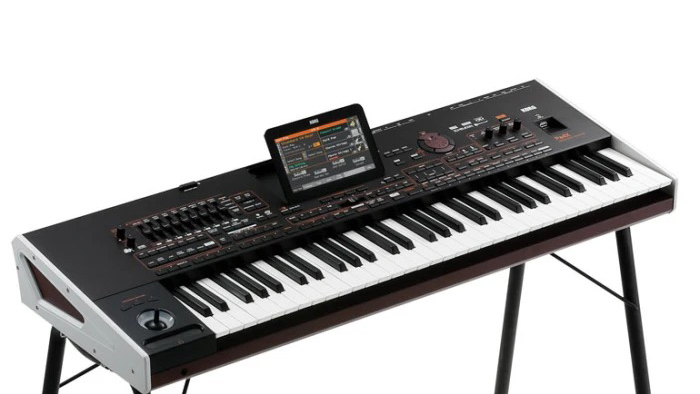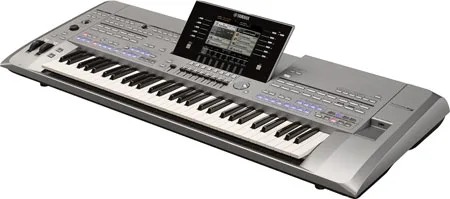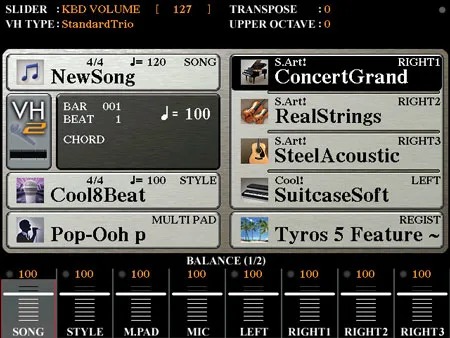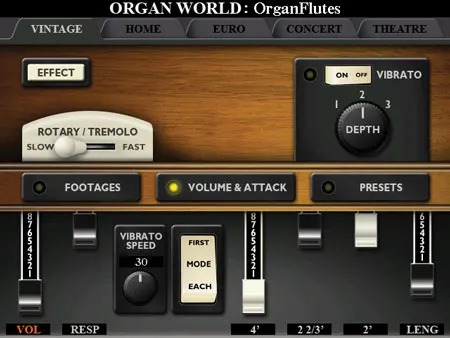Head-to-head review: Korg Pa4X and Yamaha Tyros5
Two arranger keyboards that offer sophisticated sounds

There is no more maligned and misunderstood category of keyboards than arrangers. It is certainly a cultural divide: In Europe, the UK, and across the Arab world, an arranger keyboard is the professional performance instrument, used with pride and to great effect. Here in the U.S., the category is mostly looked down upon, and the sight of onboard speakers or a button labelled Ballroom often sets off jokes and sneers.
This is a real shame, as the category has grown significantly since the early days of ’80s-era Casio and Yamaha portables. Today’s top-end arrangers offer stunning accompaniment and very advanced voice architectures, and they offer the player more sophisticated sound nuances than their workstation counterparts. So we’re staging a clash of the titans, the top offerings from Korg and Yamaha, to see what they offer the gigging musician.
- The best MIDI keyboards for beginner and pro musicians
- Best synthesizers: keyboards, module and semi-modular synths
- Best pianos: acoustic and digital pianos for beginners and pros
- Best acoustic pianos: budget to premium instruments for home and studio
- Get them started with the best keyboards for beginners
Yamaha Tyros5 vs Korg Pa4X
First, let me share some perspective. The core customer for these products is a performing musician who plays solo, or perhaps in a duo. They are the typical one-man-band types and require an instrument that can play most of the parts for them; support their singing with onboard effects, vocal harmony, and lyric display; and provide both MIDI and/or audio song playback. They are more concerned with playing their songs and putting on a good show than sound editing and technical complexity. So these products are designed with that in mind.

Here in the U.S., many gigging musicians play in similar circumstances. If you play solo in a bar or restaurant, as a duo with a singer or horn player, or three pieces without a drummer, you should be checking these instruments out. Their drum accompaniment will give you more flexibility and musical realism than a stand-alone drum machine or the unvarying drum patterns your workstation offers.
When supporting a singer, I use the drums and play left-hand bass. At times I will turn on the accompaniment so I can take a solo using a non-keyboard sound or get more realistic guitar strumming, or for rock-and dance-oriented tunes. A little goes a long way; I often mute some parts so the “band” is not so overpowering. It provides more variety than a whole night of just voice and solo piano, and it’s not as “canned” as using backing tracks since I can still vary song structures and interact with the other musicians. Do I bring it to my full-band gigs and jazz dates? Nope, I have other gear, but my arranger is the right choice for a lot of work I do.
Do you write songs? An arranger is the perfect tool for working out ideas when you are focused on melody, words, chords, and basic song structure. You can take advantage of their full “band-in-waiting” to hear your ideas right away, and make fast changes to a chord or musical style/feel without having to completely re-record MIDI parts in a DAW. Think of it this way: There is a time when you are focused on writing the song itself, and an arranger excels at that (as opposed to a sequencer, which presents you with empty tracks you have to create yourself). Do I have your attention now? Onward.
The interface
On first look, an arranger is intimidating with its crowded front panel. The Korg Pa4X has 115 buttons, ten sliders, and six knobs, whereas the Yamaha Tyros5 has 165 buttons, nine sliders, and three knobs. Whew! But they are organized into logical sections and you’ll soon find your way around. The basic sections include sound selection, style selection, style variation and drum controls, mixing, sound and layer recall for right-hand playing, trigger pads, sequencer transport controls, mic input, and vocal harmony.
Want all the hottest music and gear news, reviews, deals, features and more, direct to your inbox? Sign up here.
The 61-key Tyros5 is the larger unit at 44.8" wide and 17.7" deep. It has a large tilting panel for its 7.5" TFT colour display, with 12 surrounding buttons for making selections within the display. The 61-key Pa4X is more compact at 38.6" wide and 14.6" deep. It has a tiltable 7" TFT capacitive colour touch display. An immediate difference is that the Tyros5 has no modes: It is always ready for you to play sounds, use the accompaniment, and playback songs (see Figure 1). This makes the screen layout a bit crowded to my eyes, with Song Play and Vocal Harmony taking up space that I don’t always need to see. That said, the fonts are larger and their black-on-white layout was easier to read than the Pa4X. Below the screen are eight sliders and up and down buttons used to adjust onscreen parameters and access related functions.

The Pa4X has dedicated modes for Sound, Style Play, Sequencer and Song Play, with each mode displaying the most important things for more ready access (see Figure 2). Working with a touchscreen becomes intuitive over time, and Korg makes good use of tabs at the bottom of the screen to choose the parameters you want to see. This all translates to the Pa4X having more immediate access to needed things; the Tyros5 requires you to press more buttons and go into menus to find things.

The Tyros5 uses Yamaha’s FSX organ touch keyboard with Aftertouch. It feels great and strikes a reasonable balance for playing piano sounds as well as organ and synth. Pitch Bend and Mod Wheels, two articulation switches, one assignable slider, and three assignable pedal inputs (two switches and one sweep) provide expressive control. The Pa4X uses the same Fatar TP/8Sk keyboard as its predecessor (the Pa3X) with a solid, responsive feel and Aftertouch. It has a bit more spring-back resistance as compared to the Yamaha, but was equally expressive to play. Controllers include Korg’s familiar 4-way joystick, three assignable switches, a ribbon controller, nine assignable sliders, and two pedal inputs (one is dedicated to damper, the other is assignable). Both products support optional pedalboards to add more foot-controlled functionality.
Yamaha Tyros5 sounds
The Tyros5 has over 1,200 sounds (not including the XG sound set), which Yamaha calls Voices. Voices are made up of up to 8 Elements, which are sample-based keymaps that can be layered, split, switched etc.
The Piano Voices offer a nice range of presets. The new ConcertGrand, based on their CFIIIS piano, is 4-way stereo with a damper resonance effect. I can’t find any sign of fancier things like release samples, a separate hammer element etc., so it is not as detailed as the Korg. But it is a clean, expressive piano sure to cut through the mix. The electric pianos category offers a fair selection and the VCM effects are simply stunning, including one of the best phasers I have heard in a keyboard. They offer only one flavor of Rhodes: Most Voices sound like 4-way switching with tasteful use of key-off samples. A few DX variants, a nice Wurly, Clav and a CP-80 round out the category. Want more? You can get an expansion pack (Vintage Keyboards) that adds two more Rhodes models (‘75 MKI and ’78, basically a MKII), another Clav choice (with mutes sampled), a brighter Wurly, and more. This costs more, of course, and requires the purchase of a Flash ROM board as well.
Organs present a wide variety of sampled/rompler types. Many of the tonewheel timbres are nice “targets” with plenty of attitude, but the samples have captured Rotary Speaker and a high amount of leakage, adding some low-frequency noise to each note, which is compounded as you play more notes. Playing in a band or over the accompaniment will mask some of this, but it is very pronounced when playing the sound by itself. On the positive side, there is a wide range of combo, theatre and chapel organs, with a new interface for controlling these sounds called Organ World (see Figure 3). Vintage brings up the familiar nine drawbars, which can be controlled from the front panel sliders. A Rotary/Tremolo switch is onscreen, and the Tyros5 offers a number of Rotary Effect algorithms, including dual rotary and Distortion+Rotary choices. A second page offers control over volume, Response (which controls both the attack and the release of the sound), Vibrato Speed, and Attack, which we know as percussion. It offers three footage choices (4, 2 2/3 and 2), which can be mixed, with adjustable length. It’s nice, but not very authentic. You can choose between “proper” first-note only triggering or polyphonic. Lastly, you can store 8 presets for instant recall, and store/load more groups of them by using the Registration function.

Home organ offers eight tabs of Flute tones at 16', 8', 5 1/3', 4', 2 2/3', 2', 1 3/5', and 1'. Euro Organ offers the same sizes with the addition of 1 1/3'. Both have the same Volume and Attack and Preset type pages. Concert presents a wonderful pipe organ with eight presets that sound absolutely wonderful!
Yamaha has a number of names and technologies associated with sounds. These include Sweet!, wind and brass instruments with sampled natural vibrato; Cool!, electronic instruments sampled through their power amp and speaker components rather than direct; Live!, a stereo sampled instrument along with the natural ambience of the space it was recorded in; Super Articulation1, Yamaha’s first-generation of gesture-based response (often this will involve differences in staccato and legato playing, as well as your dynamics); and Super Articulation2, which was new to the Tyros3 but goes much further in the 5. Two switches can be used to bring in gestures on the attack of the note by pressing the switch before you play. You can affect the release of a note by pressing the switch while holding a note. Playing legato notes of a certain interval range can also produce slides, glisses, and effects.
The Strings are uniformly excellent and make good use of the Articulation switches. Brass and woodwinds are outstanding: I got lost playing the S Art saxes, Muted Trumpet and Jazz Flute; using the switches and legato notes to produce beautifully expressive phrases. Acoustic and Electric guitars were really well done, beyond the usual expectations of a keyboard. Lots of high quality scat vocals are to be found, along with plenty of synth sounds, leads and pads, basses and drums.
To tweak a Voice you get Touch Sens. Depth and offset, Mod Wheel routings, Filter Cutoff, Resonance, Attack, Decay, Release, and Vibrato depth, speed and delay. No deeper editing is possible on the unit. You can use software called Yamaha Expansion Manager to edit Voices (except for any of the Super Articulation types), but even then aspects were missing, like Element velocity switch points or the ability to change the waveforms. This is important to consider.
Ensemble Voices are a new function that intelligently splits up voices so they each fill a part of the chord being played. I quickly dialed up an old school R&B horn section, and the trumpet always played the highest note, the sax the middle, and a trombone on the bottom. I tried a pseudo-TOP section, with trumpet on top, two tenors in the middle and a barking bari on the bottom—perfection. This also works great for string quartets or blends of orchestral woodwinds. I liked playing chord support with some brass and woodwinds while soloing on a flute as if I had a floating split point; I could move around freely not worrying where one sound ended and the next began. This is a game-changing technology and it will be hard to go back to my usual instruments after having played it.
Korg Pa4X sounds
Sporting over 1,800 sounds, the Korg Pa sound engine is extendable, offering up to 24 oscillators that can be layered, key split, velocity split and much more. The Concert Grand uses them all in a stereo 6-layer sound, including key-off samples, resonance, leakage (single sample of cavity noise), hammer noise, and pedal on/off effects. It is wonderfully detailed and expressive, and you can customize it to your taste thanks to full editability. There seems to be three different acoustic pianos plus an upright, and the beloved/dreaded M1 piano.
The EP’s are a mixed bag. There are some excellent Rhodes (up to 7-way switched, key on and off samples) with four flavors represented; the required DX recreations; wonderful 6-way and 2-way Wurlies; 3-way Clavs; and a 2-way CP-80. It’s a wider, more detailed palette of these essential keyboard sounds than the Tyros offers.
Organs, as with the Tyros5, often have the Leslie sampled into the sound, but these don’t have the low frequency issue I raised earlier. Only a few sounds have real rotary speaker control, and they are marked with Y+. With others, you must play a new note/chord after moving the joystick before you hear the changed speed, because they are switching sample sets. Organs with a V in the name are velocity-switched slow-then-fast rotary sounds. Yuck.
Happily, there is a drawbar mode which does a good job of modeling the tonewheel organ, with proper drawbar foldback, variable leakage, key click on and off, and the choice of whether percussion only sounds on the first note of a legato group or all. Effects provide the Chorus/Vibrato circuit and the Rotary Speaker. The Chorus/Vibrato adds too much brightness and hiss, over-exaggerating the behavior of this section, with no way to tame it.
The Pa4X has wonderful woodwinds and reeds. Korg calls their articulation technology DNC (Dynamic Nuance Control), and like the Tyros5 it provides realistic staccato versus legato phrasing, offers slur ups and fall-offs using the switches, and longer glissandos when an interval of a minor seventh or more is played. Solo Brass are equally nice, with DNC providing glisses, fall-off and doits. Legato notes over a major third play a very convincing slide up or down. Strings and Voices are well done, and the Guitar offerings are considerably improved and expanded compared to the Pa3X. The drum kits are outstanding, many with 8-way switched samples and some have variable natural room ambience.
Auto-accompaniment
Styles read your left-hand chords and produce full band accompaniment. Variations move from sparse to busier, and you can use drum fills and the Break to add more variety to your backing. Intros lead into the song, with anything from simple count-ins to fancy harmonic progressions. Endings finish your tune-up, again with very simple one-two bar patterns or more complex phrases. There are provisions for playing non-root based chords (C/G for example), and scanning your right hand while playing manual bass lines, or both hands for more pianistic playing. Both models offer three Intros, four Variations, a Break, and three Ending buttons.
Tyros5 Style Play: The over 500 Styles are very musical and genres are well covered. The Guitars are realistic across country and rock genres, and I rarely felt like the higher variations were over-produced. Some Styles use real audio drum parts that sound great and can be varied in tempo across a reasonable range. I wish Yamaha didn’t include percussion in the same audio track, so you had your choice of including it or not. Maybe in the Tyros 6.
A few highlights: Pressing the current Variation button or a different one calls up an associated drum fill, hence no dedicated buttons. I like how Synchro Start can work once and then turn off, giving me more freedom when ending a song manually. Synchro Stop can be set to a time window: I was very comfortable setting it to a sixteenth note, so all my normal chord triggering played fine, and only when I hit and quickly released a chord would the accompaniment stop. As compared to the Korg, I did not like the settings like Tempo Lock and Manual Bass were placed in the Function Menu within the Style Setting section, making it hard to know if they are on.
Korg Style Play: The Pa4X has over 500 Styles and they are really well done. Live drums, very natural guitar parts and more help the Rock, Blues, and Funk to be very convincing and fun to play. The Pa4X has more functions for re-voicing a Style than the Tyros5, like alternate drum maps for each variation, multiple Kick and Snare choices, and easy sound tweaking for each “player in the band”, including the drum kits. I also like the onscreen Play/Mute button for cutting the band down to just bass and drums. The Pa4X has four Fill buttons. I prefer this: Pressing a Variation also triggers a Fill like the Tyros5, so I get the same behaviour plus more.
Effects
Both instruments offer effects systems that serve the live keyboard sounds and the accompaniment parts. The Pa4X has ten effects blocks: the three Keyboard Tracks have one Insert Effect and two Master Effects, and the accompaniment has four Insert Effects and three Master Effects. Plenty of tools to mix your production, although some users are complaining about the limited Insert Effects for the right hand sounds.
The Tyros5 offers global Master Reverb and Chorus which is shared by all parts, and nine DSP blocks. One block is reserved for the mic input, and up to five can be used as inserts for the right hand or song playback. The accompaniment has up to three Inserts, and one of those can be configured as a third Master Effect for more flexibility.
The Tyros5 has a Master Compressor on the main output, whereas the Pa4X has licensed Waves MAXX mastering effects, which are stunningly good. Both offer vocal harmony; Korg has licensed TC Electronics TC Helicon technology.
Style creation
Both keyboards have very capable Style Recording/Editing features: I’ll give one cool shout-out for each. The Tyros5 has a Groove function to change the feel of a Style, allowing you to subtly swing, straighten, or change a groove from 16 to 8 beat, or to a shuffle. Dynamics changes the accented beat to emphasize it, or drop out beats to create a wide range of styles/feels from the same rhythm (Reggae offbeats, drop the second beat, and more). It can work on the whole style or any “player” in the band.

The Pa4X has a Guitar Mode that is an engine, similar to Applied Acoustics Systems Strum, for producing natural guitar strumming, picking, mutes, and chokes (see Figure 4). It takes your simple chord input and re-voices it as a guitarist would with choices of neck position, voicing, and use of a capo among other things. The results are very life-like.
More helpers
Both products can save sound sets for your righthand playing. The Tyros5 calls them One Touch Settings, while the Pa4X calls them Keyboard Sets. Each saves three parts for the Upper and one for the Lower. Dedicated front-panel buttons are used to select a part, with Part On/Off buttons so you can blend them. The Korg Pa4X can easily set the key range of each sound, so you can create splits, and even velocity splits: I could find no way to do this on the Tyros5.
Four pads are available for triggering one-shot sounds/effects or looped phrases. The Tyros5 can play MIDI data or audio, whereas the Pa4X is mostly MIDI, unless you create a new sound using the integrated sampler. Banks of these sounds, like the right-hand sound sets, can be saved and recalled.
Song libraries
Both keyboards can create libraries of Songs, so you can call up the right Styles, sounds, and settings for your gigs. Yamaha calls theirs Music Finder and it is a searchable database that stores the song title, tempo, time signature, a chosen Style (with its associated Multi Pad and OTS settings), with the desired Style controls preselected. Keywords can be added to aid in searching and entries can be marked as Favorites. Korg has a Songbook, which is similar, but goes deeper since you can customize the Style more, changing sounds and effects, and creating custom Keyboard Sets, Pads, and controller assignments specifically for that Song.
Yamaha has a powerful tool called Registrations that can take a complete snapshot of the current state of the instrument, or just a few of the settings. But they aren’t connected to the Music Finder in any way. So, Overall, the Korg system is deeper and more complete, but mastering the Yamaha Registration can be very powerful.
Songwriting
Both instruments allow you to record your accompaniment-based playing in real-time or via step entry. In real-time, any front-panel button push you make is also recorded, so fills, variation changes and such can be captured. Afterwards you can go into Step Edit mode and try out different chords, chord qualities, change Variations and so on.
One big difference in the products is that the Tyros5 can only record a Style change during a real-time “pass”, with no editing possible. The Korg Pa4X can easily insert or delete them, so it allows more experimentation and variety.
Verdict
There is much more these instruments do than I can cover here. Be sure to go online and read up on their dual Song Players, lyric and score display functions, as well as the sampling and audio recording features. Both sound amazing, feel great, and have a wealth of features.
The Tyros5 is markedly more expensive, and that has to figure into your decision-making. But be sure to check out Yamaha’s extensive online eco-system at yamahamusicsoft.com.
Korg has nowhere near the same level of support and add-on files for the Pa4X. But if you like to get under the hood, even a little bit, the Pa4X is going to appeal to you: No doubt it is the more flexible of the two units.
Korg Pa4X
Pros: Detailed, expressive sounds with full editing. Waves and TC-licensed effects. Powerful backing sequencer. Excellent manual.
Cons: Limited additional Styles and Sounds. Only records MP3 audio.
Yamaha Tyros 5
Pros: Pristine sound. Breakthrough Ensemble function. Superb support for additional Styles, Voices, and Songs. Powerful Registration functionality.
Cons: Expensive. Marginal amount of sound editing.
Bottom line
These are the best-of-the-best arrangers and they sound stunning. My highest compliment would be that I often thought I was listening to an audio recording, not “canned” Style playback. Offering a wealth of features, there is no clear winner based on sound and function. You need to try them yourself to see which unit grabs you the most.
KORG PA4X
$3,999.99 street (76-key);
$3,799.99 street (61-key)
EC-5 pedalboard: $79.99 street
paAS speaker system $499.00
street
korg.com

YAMAHA TYROS 5
$6,799 list (76-key); $6499 list (61-key)
MFC 10 foot controller: $349.95 List
TRS-MS05 speaker system:
$379.00 List
FL512M 512M flash memory
expansion: 512M $199.00 List FL1024M 1 GByte flash memory
expansion: $399.00 List
usa.yamaha.com
